Use the Logik.io next-generation configurator on top of Salesforce CPQ

Related References:
- Logik.io website
- Logik.io on LinkedIn
- Logik.io on Salesforce CPQ
- Logik.io YouTube Channel
- Salesforce CPQ External Configurator Documentation
Background
Logik.io is a new next-generation headless configuration engine that can be used on E-Commerce or as an external configurator for Salesforce CPQ. It pairs a highly performant and efficient solving engine on the backend with a very responsive UI for the Sales user on the front end.
I am in no way affiliated with Logik.io, and no solicitation was made towards this review. Rather, I recently had the opportunity to build out a demo using Logik.io on Salesforce CPQ, and requested permission to do a short write-up on my experience. As would be expected based on the team behind it, Logik.io is an impressive product, and I thought those of you in the CPQ space might be interested in learning about my work with the tool.
Scope of Review
I evaluated Logik.io as a configurator for specific types of products quoted out of Salesforce CPQ. On top of Salesforce CPQ it behaves as any other external configurator, so complex products can be set up to use the configuration engine out of Logik.io, while other more straightforward products (perhaps subscriptions) can continue on the standard Salesforce CPQ engine. This provides the ability to bifurcate the Sales and configuration processes as desired – either based on product or phased implementation requirements.
Scenario for Demo
For this post, I’m going to focus on the end user experience – what does the Sales user see when configuring using Logik.io? I will give a brief overview of the configuration options that lead to this end user outcome, but won’t focus on the step-by-step setup in the way that I normally do.
Administration Concepts
Logik.io employs a Blueprint concept which allows the admin to consolidate fields, and rules for those fields, into a comprehensive Blueprint. We then assign configurable Products to a Blueprint to utilize those fields and rules in configuring that Product.
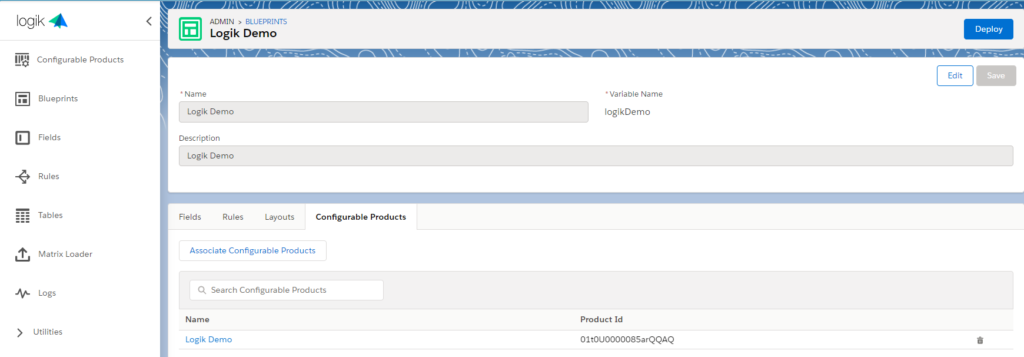
The setup tools are clean and easy to use. Most setup would be done using Matrix Loader, which is a mass load tool (using provided .csv templates) that makes for easy creation of many Fields and Rules concurrently. Manual creation is also possible and well-designed as shown below. Here I have created two Fields – ‘Country’ and ‘Language’. I’ve then configured a Rule that states if Country is set to ‘USA’ then use a Determination Action to default the Language value to ‘English’. Hiding, Exclusion, Message, Inclusion, and Product Addition actions are also available for Rules.
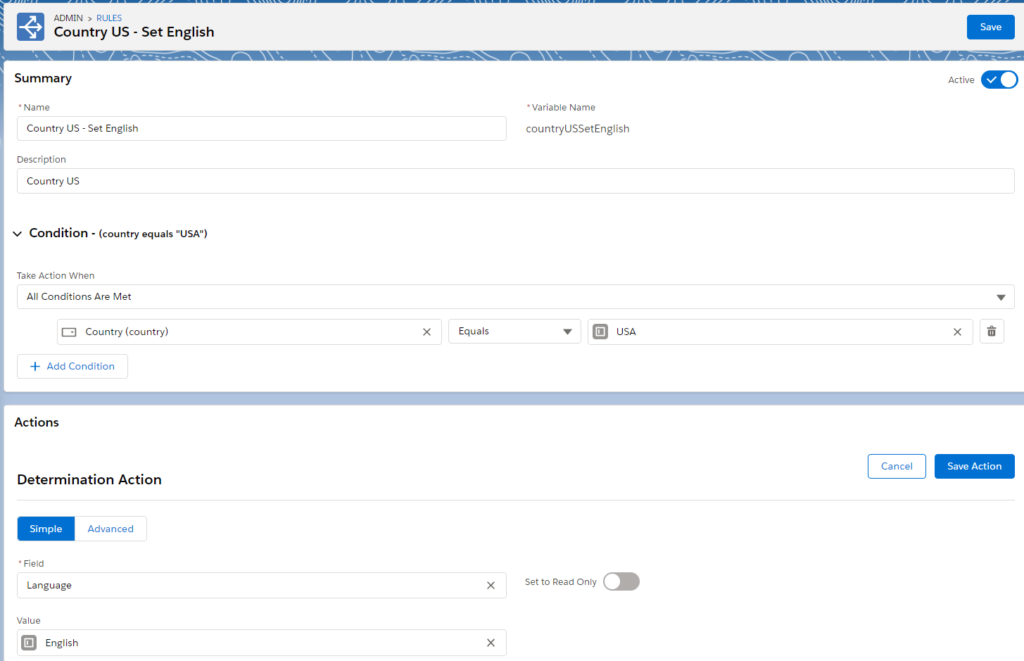
Other standard setup features supported are high-capacity Internal Tables, Advanced Functions using JavaScript (with compiler and auto-complete scoped to available fields/functions), and a layout builder employing pre-built SLDS-compatible components allowing nearly endless flexibility for displaying and interacting with the configuration.
Everything on the admin side is built API-first so configuration can be done in an automated fashion to meet business needs.
Again, I won’t dwell too long here on the admin side, but rather will get on to the main course – the end user experience.
End User Configuration Experience
Selecting a Logik.io configurable product from Add Products will launch the Logik.io configurator.
The layout builder allows a nested component structure utilizing Tabs, Wizard or single Page approach. All layouts are also responsive out of the box, so whatever we build will adjust seamlessly based on form factor. For my demo, I used horizontal tabs with collapsible sections within each tab.

Each field offers myriad options in terms of display: types (slider, multi-select, etc.), default values, styles, external plug-ins, and min/max parameters. Below I have shown some basic single and multi-select picklists.
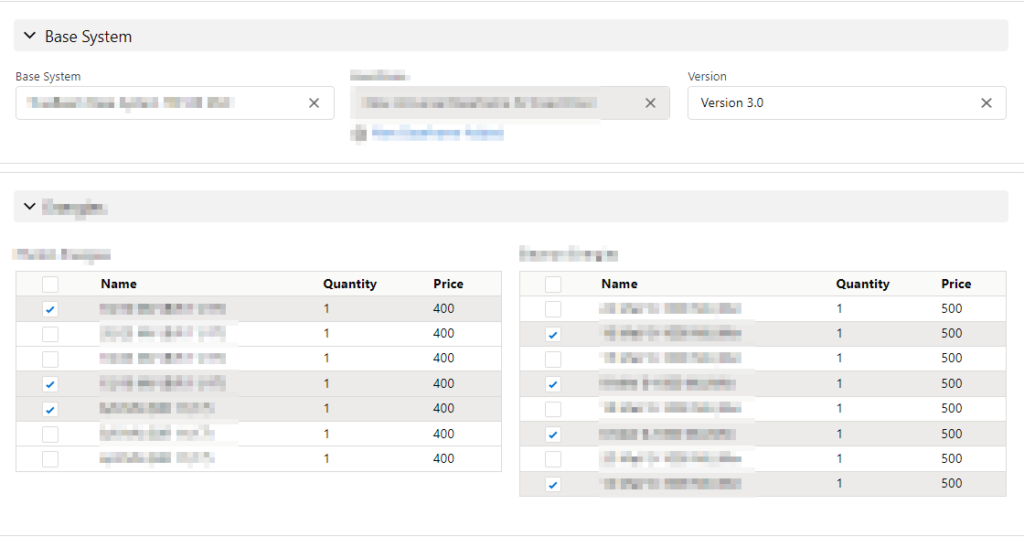
Rules attached to these fields fire immediately upon selection, so section visibility, selections and values change in a way that is barely noticeable to the user. As an example, the bottom section here is only visible when the last option of the prior field is selected and immediately shows/hides accordingly.
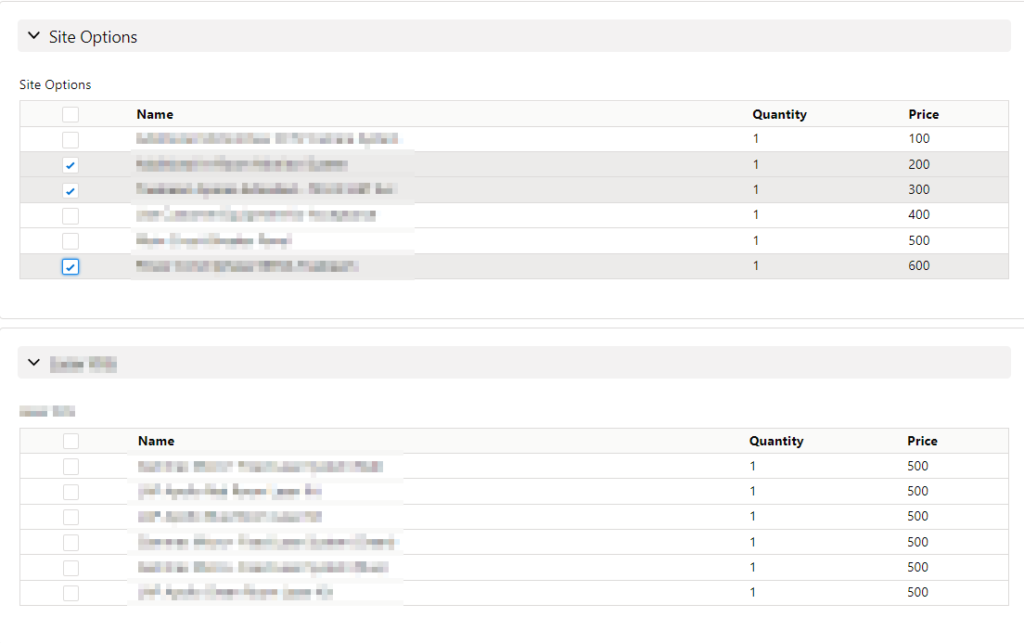
The messaging options are also excellent, and provide a great way to inform users of the impact of the decisions they’ve made, provide recommendations, etc. These can be displayed as Info, Warning, or Error format. Here I have given an example of an Info message under a Slider for Training Hours selection.

Perhaps my favorite feature is the Product List/Sales BOM (Shopping Cart). This list updates with Products real-time as selections are made and rules are executed, giving the Sales user a running summary of the results of their configuration. It is also dock-able on the Left/Right/Bottom or as a Modal. The availability of this real-time Product List is a differentiator here as this is only achievable with custom components within standard Salesforce CPQ, and that only within a separate pop-up with suboptimal performance. This real-time feedback to the user is a great feature.

Another interesting capability is that multiple layouts can be assigned to each Blueprint, and then toggled between using the layout selector. This allows Sales users to choose their favorite method of filling up a Quote rather than having to rely on a single universal input. I understand there is more functionality coming in terms of personalization, which could go a long way towards improving the efficiency of quoting for different users.

It is also important to call out that there is no ‘Update’ or ‘Apply Rules’ button anywhere on this layout. The reason is that the rules engine fires intelligently based on every change, with no administrator input/setting required during setup, and the results on the configuration are instantaneous.
I cannot share a video of the demo that I built due to limits on obfuscation, so for a quick look at the responsiveness of the tool, please check this 2 minute YouTube video. This lines up accurately with what I experienced in my mock-up, and isn’t just ‘marketing fluff’ in terms of performance.
Once we’re done with the configuration, simply hit the Quote button and those Products that have been selected via the rules engine will be returned as Quote Lines to the QLE.

Considerations for Usage Outside Configurator
An additional item to point out is that Logik.io adds Products to the configuration via either a ‘Sales BOM’ or a ‘Manufacturing BOM’ (placeholder name likely to change). Products added to the Sales BOM show up in the Product List/Shopping Cart displayed previously, and thus will map to a Quote Line automatically when using Salesforce CPQ. Products added to the Manufacturing BOM are represented via a background object and linked to a configured product via a configuration Id. This allows us to associate Products to a configuration without overloading the Quote Line Editor with additional Quote Lines. Those of you familiar with limits on the QLE will recognize that this provides an opportunity to handle more complex configurations in Logik.io and thus work around limits that might otherwise come when returning to the QLE. These background objects can then be queried for use in ERP sync, Output, etc. as needed for the unique business process.

We can also use Logik.io Rules or Advanced Functions to perform complex calculations in the configuration itself and pass to the Quote Line via optional Product extension custom properties as shown below. This allows us to do calculations in Logik.io and map into Quote Line fields via the Quote Calculator Plugin when returning to the QLE. This is another opportunity to offload items from the QLE that otherwise may cause performance or limit issues. For example, we can add 200 Products to the Manufacturing BOM, tabulate their totals into a single Sales BOM Product, and map that value into a single line on the QLE. I see this as a massive benefit in terms of dealing with highly complex or large Quotes.

Summary
Based on my review, Logik.io is clearly an exciting addition to the Salesforce CPQ space. It closes multiple gaps seen from the standard Salesforce CPQ configuration when dealing with highly complex configurations especially. The nearly instantaneous solving engine performance, paired with a modern and highly responsive UI, provides the ‘wow’ factor that is missing from the standard offering. I would encourage folks to look into what Logik.io has to offer if this quick summary has piqued your interest!
Thanks
Thanks to the team at Logik.io for their assistance with the test drive of their new product – Chris Shutts, Fazal Gupta and Vanessa Rosengarden in particular.


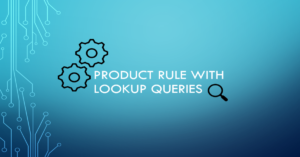
Great review
Very nice review, clear and concise!
Superb content! Excited to learn more about this powerful tool
Awesome review, thank you!
Helpful. Thanks.
Helpful. Thanks!
can you please explain how to access data tables in advance functions?